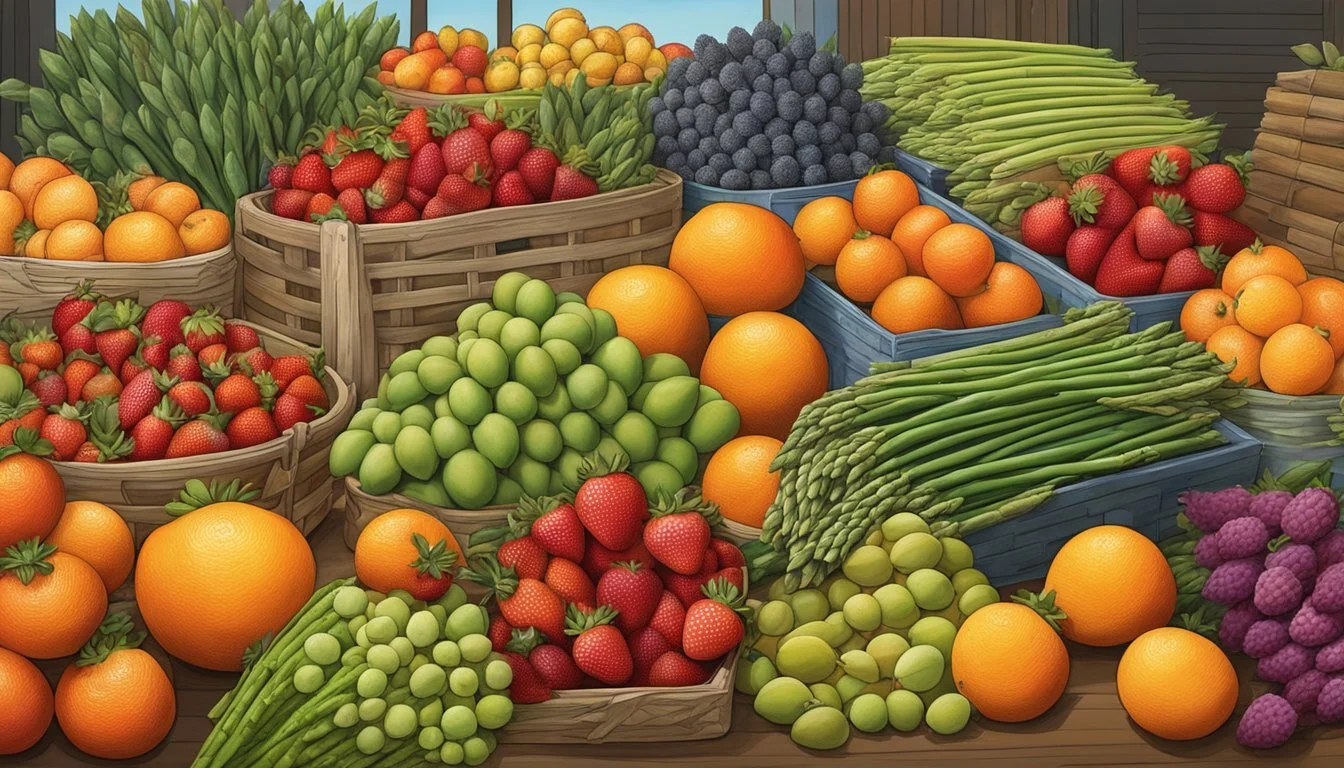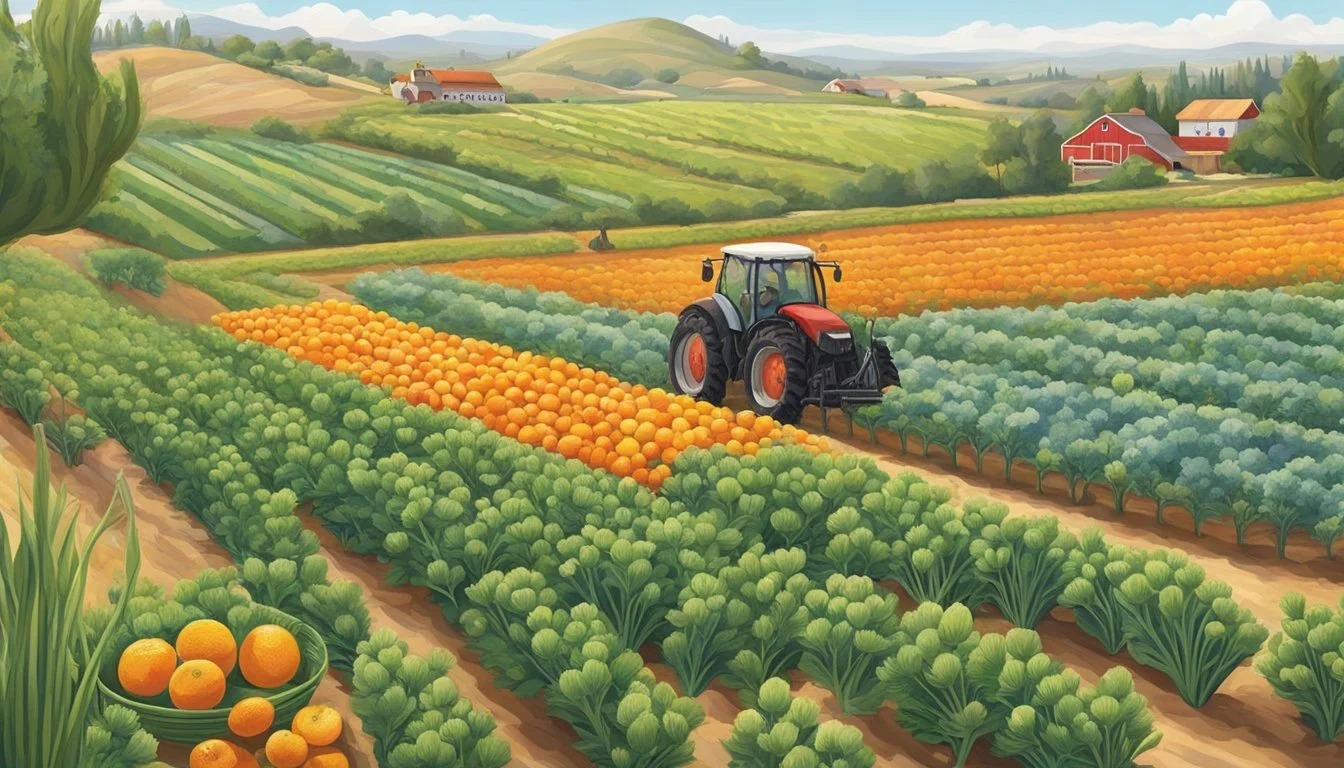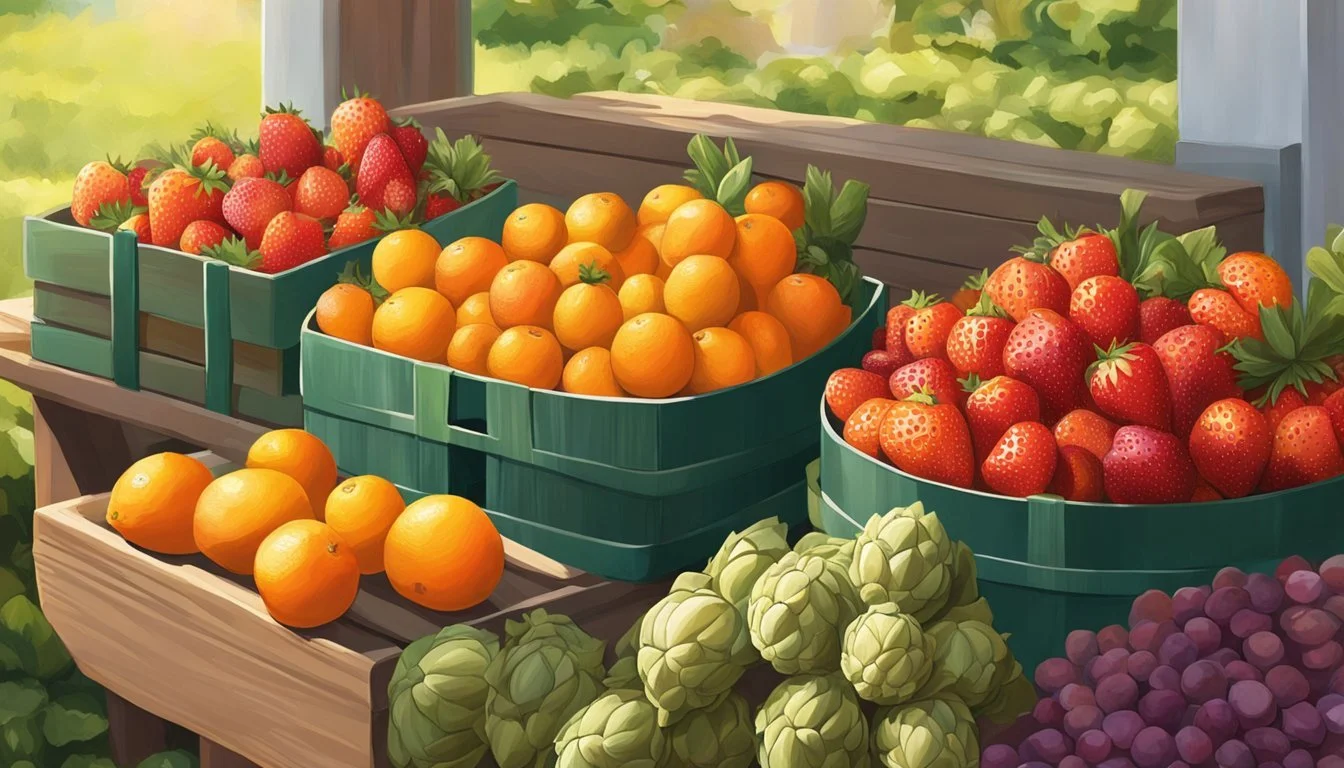California Seasonal Fruit & Vegetables in April
Your Fresh Produce Guide
This Article is Part of our California Seasonal Fruit & Veg Calendar
California's agricultural abundance is a reflection of the state's varied climate and topography, which supports a wide range of crops. In April, California's seasonal produce starts to shift, offering a diverse palette of flavors and textures. Shoppers and chefs alike look forward to this month's harvest, which brings to market some of the freshest and most flavorful fruits (What wine goes well with fruits?) and vegetables.
Seasonal fruits that typically ripen in April include strawberries, avocados, and citrus fruits like Valencia oranges. These fruits are celebrated for their freshness and are often at their peak in both flavor and nutritional value. Meanwhile, vegetables such as asparagus (What wine goes well with asparagus?), spring onions, and a variety of lettuces and greens also make a prominent appearance in California's produce sections. These vegetables signal the transition from winter to spring produce, and they provide the opportunity for light, refreshing dishes that are in line with warmer weather.
While the rest of the country might still be shaking off the last vestiges of winter, California's April produce range encourages a revitalization of cooking and eating habits. The availability of such produce makes it an excellent time to explore farmers' markets and embrace the season's offerings. This emphasis on seasonal eating not only supports local farming communities but also provides consumers with the opportunity to enjoy foods at their seasonal best.
Seasonal Overview
In California, the month of April marks a transition period where winter crops begin to wane and spring offerings reach their peak freshness. A diverse array of fruits and vegetables become available, influenced by the state's varied climate zones.
Spring Seasonality in California
April in California signifies the heart of spring, with warming temperatures and longer days, which encourage a range of produce to thrive. The state's farming regions generate an abundance of both late winter and early spring crops.
April's Peak Produce
During April, a variety of produce reaches its peak. Consumers can find the freshest artichokes (What wine goes well with artichokes?), asparagus, and strawberries, which are particularly vibrant and flavorful. Sweet onions and a wide selection of citrus fruits, including blood oranges, grapefruit, and mandarins, also feature prominently at local farmers markets.
Transition from Winter to Spring
As April progresses, the tail end of winter produce, such as citrus fruits and root vegetables, begin to give way to the bright and tender offerings of late spring. This includes the appearance of edible flowers like nasturtium and pansies, heralding the arrival of a new growing season.
What's Ending, What's Beginning
The period of March to May sees the last of the winter favorites like kiwi and kumquats, while cherries (how long do cherries last?) and peas signal the advent of late spring. By June, many of these fruits and vegetables will be out of season, making room for the summer selections.
Regional Variances in California
California's agriculture benefits from a tapestry of microclimates, from the cooler coastal areas to the warmer inland valleys. This means that while artichokes may be flourishing on the coast, inland farms might be delivering the first of the stone fruits like peaches and nectarines.
Seasonal Eating Benefits
Eating seasonally in April ensures consumers enjoy fruits and vegetables at their nutritional and flavorful best. It also means a more exciting variety, as different produce items become available throughout the season.
Environment and Sustainability
Choosing seasonal produce helps reduce the environmental impact associated with long-distance transportation. It supports sustainable farming practices that are better aligned with California's natural growing cycles.
Supporting Local Farmers
Purchasing seasonal produce directly from local farmers markets benefits the community. It sustains local agriculture and ensures that farmers are rewarded for their efforts. Consumers also benefit by getting the freshest produce possible and the chance to build relationships with the people who grow their food.
April Fruits
April in California marks a vibrant transition period for fruit, offering an abundance and variety that caters to all tastes. From the last bursts of citrus to the early signs of summer sweetness, this month's harvest captures the essence of spring.
Citrus Fruits
In April, citrus fruits are still plentiful, with Grapefruit and Lemons being widely available. Oranges, including varieties like the Valencia, remain juicy and sweet. This is also the season for Tangelos and the tail end for Mandarins, offering consumers a final chance to enjoy their unique flavors before summer.
Grapefruit: Still in peak season, grapefruit is both juicy and tart.
Lemons: Abundant and versatile for culinary uses.
Oranges: Valencia oranges are particularly sweet during April.
Tangelos: A flavorful hybrid of tangerines and grapefruit.
Mandarins: Wrapping up their season, they offer a last taste of winter citrus.
Berries and Cherries
Strawberries come into their own in April, becoming a star in the berry category for their sweetness and versatility. While Cherries may start to appear by the end of the month, hinting at the stone fruit season that lies ahead.
Strawberries: Bright, sweet, and a sign of spring.
Cherries: Beginning to arrive, signaling the crossover into stone fruit season.
Tropical and Exotic Varieties
Avocados, especially the Hass variety, continue to thrive in April, with their creamy texture and rich flavor.
Avocados: Peak season continues, ideal for diverse culinary applications.
Stone Fruits Previews
While still early, some early varieties of Apricots and Nectarines may begin to show up in markets as an exciting preview of the forthcoming stone fruit abundance in California.
Apricots: Early varieties may appear.
Nectarines: Begin to hint at summer's arrival with their vibrant taste and color.
Pome Fruits Availability
Apples, having been stored from the fall harvest, remain available. They offer a crisp and refreshing crunch that can still be savored even as the season transitions.
Apples: Continue to provide a fresh, crisp flavor and texture.
Melons and Summer Preview
April might give a limited preview of early Melons, such as cantaloupe (how long does cantaloupe last?) or honeydew, offering a glimpse into the refreshing tastes that fully come into season during the summer months.
Melons: Early varieties may start to appear, teasing the palate for summer.
April Vegetables
As April arrives in California, a variety of vegetables come into season, known for their burst of green and flavor. Farmers' markets begin to showcase a broader range of vegetables, from leafy greens and aromatic herbs to earthy root vegetables and crisp legumes.
Leafy Greens and Herbs
The spring climate ushers in a collection of leafy greens including spinach, lettuce, and kale, all heralding the season's freshness. Herbs such as parsley, cilantro (how long does cilantro last?), and chives gain vibrancy, enhancing dishes with their distinct flavors.
Spinach
Lettuce
Kale
Parsley
Cilantro
Chives
Root Vegetables
April's earth offers a selection of root vegetables that carry not only essential nutrients but also rich, deep flavors. Among these are potatoes, carrots, and beets, with radishes, turnips, and horseradish adding a peppery and pungent edge to the palate.
Potatoes
Carrots
Beets
Radishes
Turnips
Horseradish
Legumes and Pods
Podded vegetables such as peas, fava beans, (how long do fava beans last?) and snap peas emerge, signifying the heart of spring. These beans offer a crisp, sweet taste and are often eaten fresh, straight from the pod.
Peas
Fava Beans
Snap Peas
Cruciferous Vegetables
The cruciferous family makes a strong showing in April, with broccoli, cauliflower (how long does cauliflower last?), and Brussels sprouts (how long do brussels sprouts last?) taking center stage. Their dense nutrients and distinct flavors make them a favorite in many seasonal recipes.
Broccoli
Cauliflower
Brussels Sprouts
Alliums and Earthy Flavors
Alliums, such as onions, leeks, shallots, and garlic, continue to be harvested. Their earthy flavors (What wine goes well with earthy flavors?) are a staple in many dishes, laying the flavor foundation for both complex and simpler meal preparations.
Onions
Leeks
Shallots
Garlic
April's Versatile Veggies
Not to be overlooked, asparagus and artichokes present a unique taste of the season and are often featured in springtime feasts. Mushrooms, varying in type, also become available, offering an earthy umami to any dish.
Asparagus
Artichokes
Mushrooms
With the season in full swing, these vegetables bring not only color and taste to the table but also a wealth of health benefits characteristic of April's harvest.
Farmers Market Guide
Visiting California's farmers markets in April offers an abundance of fresh, in-season fruits and vegetables. Shoppers will find a variety of colorful produce and can enjoy the peak flavors of the season.
Shopping at Farmers Markets in April
During April, farmers markets across California are vibrant with an array of fresh produce. Shoppers are encouraged to arrive early to access the best selections. One can find staples such as strawberries, artichokes, and asparagus, which are notably fresh and flavorful in this period. Citrus fruits, like oranges and lemons, are still available, while the early arrivals of stone fruit hint at the incoming summer bounty.
Understanding Seasonal Availability
In April, the diversity at farmers markets is a reflection of California's rich agricultural landscape. Seasonal availability is influenced by local climate and weather patterns, making some items more prevalent:
Fruits: Strawberries, Citrus (Oranges, Lemons), and early Stone Fruits (Apricots)
Vegetables: Artichokes, Asparagus, Greens (Spinach, Lettuces), and Spring Onions
Being aware of what's in season helps in planning meals around the freshest ingredients while supporting sustainable agriculture.
Farmers Market Etiquette
A farmers market visit is more than a shopping trip; it's an opportunity to connect with local farmers and learn about the source of one’s food. Shoppers should:
Ask questions: Farmers usually appreciate sharing information about their produce and farming practices.
Handle produce with care: Respect the effort that goes into growing the food by handling it gently.
Bring reusable bags: This reduces waste and supports environmental efforts.
Stay patient: Markets can be busy; a polite and understanding attitude ensures a pleasant experience for everyone.
Seasonal Recipes and Preparations
In April, California's bounty includes vibrant asparagus spears, fresh artichokes, and sweet strawberries, offering numerous options for both traditional and inventive recipes.
Spring Recipe Ideas
They can enjoy the spring harvest with simple yet flavorful dishes. Asparagus, steamed to perfection, can be enhanced with a sprinkle of sea salt (how long does sea salt last?) and a drizzle of olive oil, or incorporated into a creamy risotto. Artichokes find their glory when grilled and served with a garlic aioli. For dessert, strawberries can be transformed into a refreshing sorbet or a classic shortcake, celebrating the fruit's natural sweetness.
Preserving April's Bounty
With the surplus of produce, preserving techniques allow one to savor April's flavors year-round. Strawberries are excellent for making jams or can be frozen for later use in smoothies and pies. Pickling asparagus preserves its crispness while adding a tangy flavor, suitable as a snack or in salads. Artichokes can be marinated in an herby oil mixture and kept in jars, ready to add to antipasto platters.
Cooking Techniques for Seasonal Produce
When cooking with April's seasonal produce, emphasizing their freshness is key. Roasting brings out the natural sugars in vegetables, making caramelized carrots or root vegetables an excellent side dish. Sautéing asparagus quickly in a hot pan preserves its crunch and bright green color. Strawberries can be macerated with a bit of sugar to release their juices, perfect for topping cakes or mixing into yogurts.
Salads, Sides, and Entree Highlights
This month's produce shines in a variety of dishes. Creating a vibrant salad, they can toss together mixed greens, sliced strawberries, and nuts, dressed with a balsamic reduction. Steamed artichokes make a delightful side, especially when paired with a light lemon butter sauce. For entrees, incorporating roasted asparagus into a pasta dish adds both texture and a pop of color.
Gardening Tips for April
April in California is a critical period for gardeners to set the tone for a productive late spring and summer season. With careful planning and maintenance, one can cultivate a vibrant garden overflowing with fruits, vegetables, and herbs.
What to Plant in April
Vegetables: Gardeners in California can plant a variety of vegetables in April. Sowing seeds for green peas, broccoli, cauliflower, cabbage, brussels sprouts, carrots, beets, lettuce, parsley, cilantro, and spinach is advisable for an abundant harvest.
Fruits: For those with fruit trees, it's the right time to enjoy avocados (like the Hass variety) and an assortment of citrus fruits, including Valencia oranges and Gold Nugget mandarins. This is if they were planted in the correct previous season.
Herbs: April is also optimal for planting herbs. One can sow seeds or transplant seedlings of herbs such as cilantro, which thrives in the cool to warm transition of the California April climate.
Maintaining Your Spring Garden
Watering: Adjust irrigation practices with the rising temperatures, ensuring an adequate, but not excessive, amount.
Mulching: Apply mulch to conserve moisture and suppress weeds.
Fertilizing: A balanced, slow-release fertilizer can encourage the healthy growth of newly planted vegetables and fruit-bearing plants.
Deadheading: Regularly remove spent flowers from blooming plants to promote continued flowering.
Pest Management and Organic Practices
Inspection: Regularly inspect plants for signs of pests or diseases, catching issues early can prevent widespread damage.
Organic Pesticides: If pests are detected, opt for organic pesticides to minimize the impact on beneficial insects and the environment.
Beneficial Insects: Attract beneficial insects such as ladybugs and lacewings by planting companion plants that bring ecological diversity and balance.
In summary, April gardening requires a blend of planting new crops and maintaining the existing ones, coupled with diligent pest management to enjoy a flourishing garden in the seasons to come.







